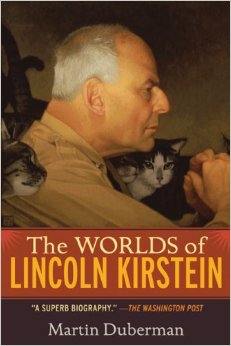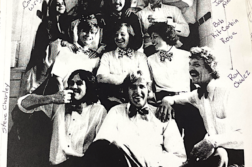 The Worlds of Lincoln Kirstein
The Worlds of Lincoln Kirstein
by Martin Duberman
Alfred A. Knopf. 736 pages, $37.50
LINCOLN CENTER wasn’t named after Lincoln Kirstein, but perhaps it should have been. Did anyone equal his achievements in nurturing high culture in 20th-century America? Kirstein’s craggy, eagle-like countenance seems like a ready-made monument to worthy instincts and impossible adventures.
Most people barely know his name. Only now, on the 100th anniversary of his birth, do we have a rich biography that presents his full contribution. Martin Duberman makes Lincoln Kirstein come alive on the page and demonstrates the panorama of his life. The Worlds of Lincoln Kirstein goes light years beyond the familiar and inadequate capsule version of the bio, which usually goes like this: he brought George Balanchine to the United States and started the New York City Ballet. While Kirstein may be remembered primarily for those accomplishments, readers of this biography will also learn of his pioneering work as editor, publisher, curator, writer, leftist, and virtuoso at manipulating the rich and the talented toward visionary ends. Kirstein’s life followed a time-honored American tradition: The first generation of immigrants is followed by a second generation that succeeds in business—in the case of Lincoln’s father, it was Filenes’s retail department store in Boston—and leaves the third with enough money to devote itself to the arts. Lincoln’s father was not only successful but generous.
Kirstein’s beginnings as a student were not promising. One instructor wrote to his mother, “I must tell you that your son is fearfully scatter-brained and prone all too often to wander down imaginary by-ways of his own devising,” and a headmaster at Phillips Exeter described him as “unsuitable.” Kirstein had to take the Harvard exams three times before he could enroll. But from the moment he entered Harvard in 1926, he shifted into high gear and never stopped. During his sophomore year, he started a quarterly literary magazine, Hound and Horn, which published everyone from Edmund Wilson and Katherine Anne Porter and William Carlos Williams to T. S. Eliot and James Agee.
In his junior year in early 1929, Kirstein founded the Harvard Society for Contemporary Art, which anticipated much of Modernism while adding film, photography, and design into the usual mix of painting and sculpture. One could see a model of Buckminster Fuller’s Dymaxion House, Alexander Calder’s impromptu wire sculpture, Henri Matisse’s paintings, Walker Evans’ photographs, designs by Donald Deskey, among a dizzying variety of other pieces. Remarkably ambitious and catholic in his tastes, these exhibitions on the second floor of the Harvard Coop now look like an ad hoc template for the Museum of Modern Art, which was founded eight months later.
Before Kirstein dedicated himself to ballet, he explored widely. While serving as an editor and curator, he avidly sampled Harlem nightlife, left-wing politics, and Gurdjieffian mysticism. He painted, he wrote a novel (Flesh is Heir), he cruised New York high and low for sex with men. All this happened while he was in his early twenties. His guide through much of this period of formation was the sharp-witted high bohemian hostess, Muriel Draper, who was a generation older than he. When she learned that Kirstein had unwittingly witnessed the funeral of the Ballets Russes impresario, Sergei Diaghilev, in Venice in 1929, she considered it a sign that he would bridge two eras. In a 1931 diary entry, Kirstein wrote, “Muriel said she thinks my true forte was as an organizer and a catalyst. That I was frightened of being bored so I painted and wrote as an excuse so that I wouldn’t organize, that I would have a lot of power one day.”
The formative years of this brilliant young man are enthralling, especially because the combination of attributes that Kirstein presented posed such potential tensions: he was Jewish growing up in the capital of Brahmin culture, the first son in an upwardly mobile family, primarily homosexual, smart but perhaps learning disabled, probably bipolar.
In the summer of 1933 Kirstein went to Paris to find a worthy collaborator for continuing Diaghilev’s achievements in America. Balanchine’s choreography for the single season of Les Ballets 1933—bankrolled by Edward James, a wealthy English eccentric, to showcase his wife Tilly Losch—convinced Kirstein that Balanchine was his man. He invited him to the United States, arranged passage, and organized backers, thanks to the febrile imagination of Chick Austin at the Wadsworth Atheneum and the money of Eddie Warburg. When he accepted the invitation, Balanchine had insisted that one must provide training: “But first a school,” he instructed. The School of American Ballet, founded at the end of 1933, has ever since provided the spine of ballet training in the U.S.
Kirstein was an unlikely administrator but over the years acquired the pragmatic intelligence needed to steer his company through its shifting identities as the Ballet Caravan and the Ballet Society. After several far-flung tours the company found its first home at City Center and ultimately at Lincoln Center, beginning in 1964. We now consider the New York City Ballet as a venerable institution, but for decades it was touch-and-go.
Martin Duberman was a regular among the audiences that religiously followed the company from the 1950’s on. In his biography he does not try to recreate what he saw onstage. (For eyewitness accounts of those wonders, read Joan Acocella, Arlene Croce, Edwin Denby, Robert Gottlieb, Robert Garis, and, of course, Kirstein himself.) But it makes a difference that he witnessed the dancers that pepper these pages. The uninspired layout of photos in the biography misses the opportunity to suggest that beauty or continuity, though that’s probably not Duberman’s fault.
Duberman’s description of Kirstein’s complex sexual life is especially nuanced and even-handed. This comes as little surprise, since Duberman has dedicated much of his life to gay history and autobiography. He founded the Center for Lesbian and Gay Studies (clags), wrote Cures: A Gay Man’s Odyssey in 1991 and Stonewall in 1993, not to mention many others, including plays such as In White America (1964), biographies of Paul Robeson and Charles Frances Adams, among others, and compilations of essays about politics and sexuality.

The conventional model for the pre-Stonewall homosexual featured torment, shame, and suicide. (The first guiltless depiction of homosexuals was The Young and Evil, by Charles Henri Ford and Parker Tyler, published in 1933.) There is little torment or shame here. Nor, thank God, does Duberman grab the opportunity to shape Kirstein’s life into a “correct” retrospective view. Along the way, Kirstein connected with sailors along Sand Street in Brooklyn, men in the showers of the 63rd Street YMCA, Harvard undergraduates, and men on the street. Although the scars from a botched circumcision added some anxiety to his sexual performance, Kirstein enjoyed the animal nature in himself and others (and later in his pets). He harshly judged himself for many failings, but sexuality was rarely among them.
When I met him a few years before he died, Kirstein said, “Everyone was homosexual.” I did not take this as a statement of fact, but as an attitude that was widespread when he came of age in the late 1920’s. He slept with women but was more attracted to men. He had flings with many and longer affairs with a few (notably dancer Pete Martinez, artist Dan Maloney, conservator Jensen Yow). In his diaries he regularly explored connections that were physically unrealized. What often began with sex ended in long friendship. Kirstein’s life and imagination demonstrates that what some call love comes in many varieties.
Kirstein married Fidelma Cadmus in 1941, and their marriage lasted until her death fifty years later. The conflicts between them had little to do with jealousy or infidelity. Some of his boyfriends shared their house at 128 East 19th Street. Fidelma was enormously fond of most of them. She was the sister of painter Paul Cadmus and a promising artist herself. In the shadow of Kirstein, she never developed her talent. Without blaming Kirstein, who encouraged her, Duberman describes the difficulties in their marriage that hampered her artistic career.
It is impossible to describe in a few words Kirstein’s later contributions, which include the City Center, Stratford in Connecticut, Dance Index, the Dance Archives, Pippin Press, Lincoln Center, and more. For all this, one must read the biography. Duberman brings us very close to Kirstein, in part because of his astute use of letters along with the eloquent and unflinching diaries Kirstein kept from 1919, when he was in summer camp, to the late 1930’s. Kirstein’s voice in his diary, volumes of cramped cursive handwriting, is hard-headed, gossipy, frank, and intimate. The range of people who appear so prominently in the diaries (including Romola Nijinsky, Alfred Barr, Sergei Eisenstein, and Nelson Rockefeller) is a name-dropper’s dream. Even George Balanchine, so thoroughly documented, emerges in a newly shaded way.
Duberman steers a straight course between hagiography and pathography. He clearly admires and likes Kirstein, but doesn’t ignore his problems. In his lucid periods, Kirstein’s comments to others could seem cruelly direct (though rarely wrong). Two examples, directed to the high and the low, show his style. Addressing John Rockefeller after helping to develop Lincoln Center, Kirstein wrote: “Four years taught me: the criterion is manipulation of real-estate sweetened by the education-business. Your associates are not inimical to art; to them it is not real. Their habit is compulsive charity to maintain dynastic prestige.” He was equally blunt to a young corps dancer who was distraught in the belief that “Mr. Balanchine hates me.” Kirstein replied, “He doesn’t even know you exist.”
After middle age, Kirstein had wider swings of mania, depression, and paranoia. The full wrath of Lincoln Kirstein in these periods could not be contained. He destroyed the studio of his friend Dan Maloney, for example, and sometimes ended in a straitjacket for weeks in a psychiatric hospital. However, this did not stop his creative energy until near the end of his life.
At its best, The Worlds of Lincoln Kirstein is a pas de deux between biographer and subject. As Kirstein was to Balanchine, Duberman is to Kirstein. He has done the behind-the-scenes work. In writing biography, poetry comes only after the labor. Duberman’s groundbreaking biography fulfills its title: Lincoln Kirstein commanded many worlds.
Steven Watson has written about the American avant-garde, the Harlem Renaissance, the making of Four Saints in Three Acts, and the Beat Generation. His latest book is Factory Made: Warhol and the Sixties.






